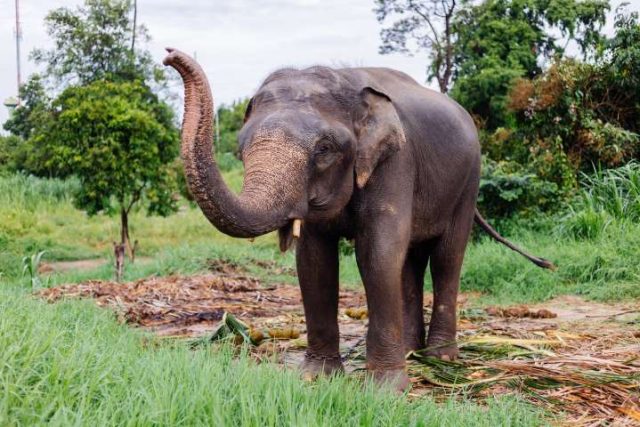
Thailand is best known for its tropical beaches, lavish royal palaces, ancient ruins, and beautifully decorated temples. The Land of Smiles also offers amazing wildlife encounters, making them a popular destination for animal tourists.
From dolphins, sharks, and whales, to tigers, turtles, and even elephants, Thailand is filled with magical biodiversity where tourists worldwide can have a safari-style experience.
Ethical animal tourism simply means observing animals in their natural habitat, i.e., from afar. So how will you know whether the sanctuary is ethical?
Look for advertisements suggesting bathing or riding an elephant as entertainment. These companies look for profit rather than taking care of these large mammals.
In ethical sanctuaries, companies put the needs of wild animals first rather than look for profit or human convenience. Here are ten ethical elephant sanctuaries you can visit in Thailand, where you’ll meet many free-roaming elephants.
1. Elephant Nature Park
Elephant Nature Park is located in Chiang Mai, the third largest city in the nation, and can be found in mountainous northern Thailand.
The sanctuary was created in partnership with 137 Pillars Hotels and Resorts Thailand’s CSR. They focus on global awareness of elephant conservation and reforestation. It is a rescue center for mistreated elephants where you can observe and volunteer to help them for a day or two.
If you want to connect with nature, what better way is there than being among the world’s largest mammals in their natural environment? You can stay overnight or become a volunteer if you plan on staying longer.
2. Four Seasons Tented Camps
Located near the border of Myanmar and Laos, Four Seasons Tented Camps is perched on the countryside hills of Chiang Rai, another city in northern Thailand. This is considered one of Thailand’s hidden resorts as it is accessible only by river boats.
Enjoy a spectacular view of the bamboo forests and hike on mountainous trails, and interact with rescued elephants. You’ll be able to enjoy a full safari-style experience while enjoying a luxurious stay in the tents.
3. Boon Lott’s Elephant Sanctuary
This small and peaceful sanctuary is located in Sukhothai in northern Thailand. They strive to rescue and protect elephants from abuse and extinction.
With 600 acres of forest land, a banana plantation, freshwater rivers, and open fields, they intentionally keep the number of visitors low for the well-being of the small herd of rescued elephants.
4. Burm and Emily’s Elephant Sanctuary
Located in a stunning rural area south of Chiang Mai, Burm and Emily’s Elephant Sanctuary (BEES) is the kind of place where elephants can get to spend their golden years. It provides refuge to not only the rescued ones but also the old and the injured.
You can join their volunteer programs in taking care of the elephants. The activities include cutting grass, providing corn for the elephants, clearing their areas, and so on.
Try joining their regular programs, such as cooking classes at a local village, taking tree planting courses, or learning basic survival skills in the jungle.
5. Elephant’s World
A haven for rescued and injured elephants, Elephant’s World has plenty of space filled with lush green forests and a peaceful setting on the banks of the River Kwai.
Founded by Thai veterinarian Dr. Samart and his wife Khun Fon, the refuge began with rescuing three elephants. Now it has 25 animals rescued from logging and trekking camps, mostly malnourished and injured.
Interaction has been respectfully limited with these elephants, but visitors can watch them foraging, bathing, and socializing from a distance. Like other sanctuaries, you can visit for a day, stay overnight or volunteer to help if you plan to stay longer.
6. Samui Elephant Sanctuary
Samui Elephant Sanctuary is one of the first ethical sanctuaries in Koh Samui. It provides a safe place for mistreated, abused, and injured elephants where they can now roam freely, play in their custom-built pool, and slide in mud pits.
Visitors are allowed to walk and observe the elephants as they forage, play, and socialize with other elephants in their natural habitat.
The sanctuary has received various recognitions, such as the Best Animal Welfare award from the Tourism Authority of Thailand for two consecutive years and the Best Practice Elephant Venue by World Animal Protection (WAP).
You can also visit the Beach Samui for a retreat and a relaxing experience where you’ll be treated with herbal extracts and cannabis-infused candles and oils to give you that relaxation you very much need.
- Phuket Elephant Sanctuary
A sister project by Save the Elephant Foundation, Phuket Elephant Sanctuary focuses on the treatment and rehabilitation of old and injured elephants.
Rescued elephants between the ages of 30 to 70 years old stomp freely across lush green pastures in the picturesque jungle bordering Khao Phra Thaeo National Park.
Here, visitors can watch the elephants from treetop observation decks as they graze, bathe and splash on the freshwater lagoons and mud pools.
- Elephant Hills
Elephant Hills sanctuary is home to many rescued elephants who spent life in captivity and are now free to roam without chains holding them back.
Located in the Khao Sok National Park, the people at Elephant Hills are constantly working to improve environmental conditions and the quality of life for the elephants.
The special thing about this sanctuary is that you get a chance to stay at one of its sites’ glamping camps, fully immersing yourself in nature. You can also take part in kayaking, trekking, and hiking through mangrove forests and visiting local markets.
In a Nutshell
After much scrutiny, Thailand has embraced ethical animal tourism and has provided safe sanctuaries for its national animal: elephants.
Elephants were used in wars, logging, and trekking to the point of them being abused, starved, and mistreated. Now, they have safe spaces to roam freely without human intervention.
How can you contribute as a visitor? Just by observing them from afar or becoming a volunteer to help take care of them. Stay overnight, try out various activities, visit local markets, connect with nature, and watch these majestic animals stomping freely in the place they call home.






